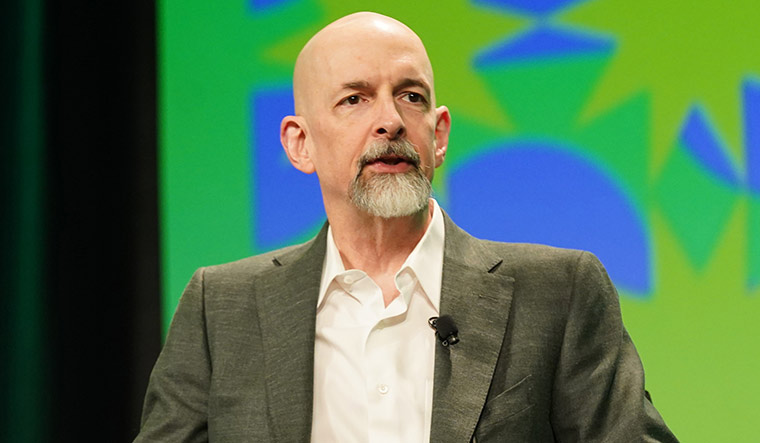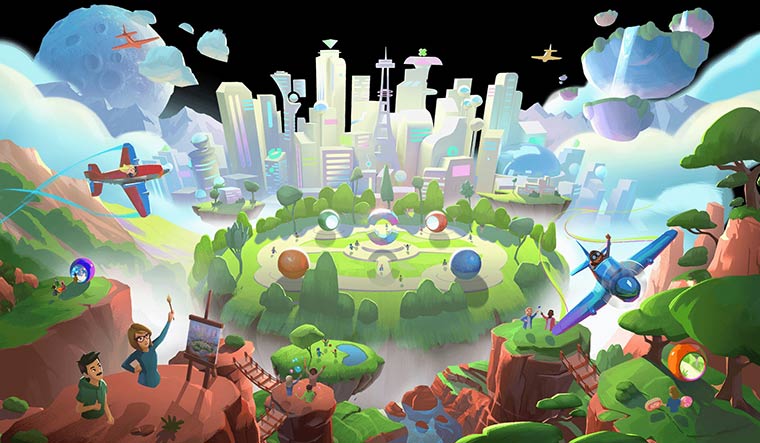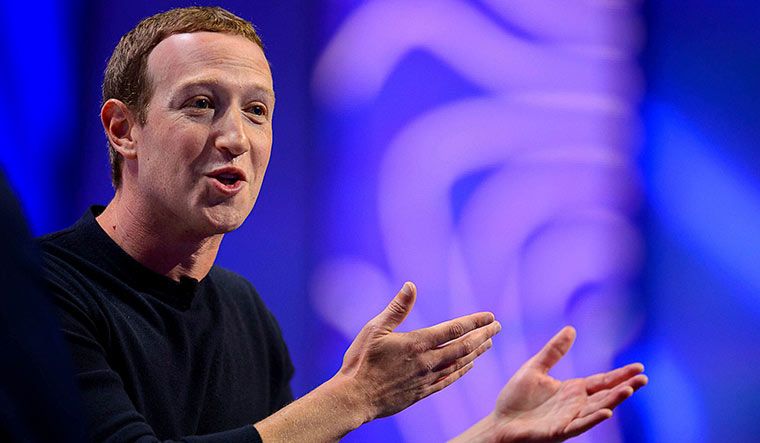A dystopian future is a common theme in science fiction. The 1992 novel Snow Crash by Neal Stephenson was set in such a future—the 21st century after a global economic collapse. The world’s territory has been carved up into sovereign enclaves run by big business. It is an unpleasant existence for the common man, to say the least.
Stephenson describes a technology that resembles today’s multiplayer online video games. It is a computer-generated universe that is projected on to users’ goggles and pumps into their earphones. Users can build things in this virtual reality, including spaces where the laws of physics are ignored, and combat zones, where the digital avatars of users can hunt and kill each other. In order to build, they have to pay the Global Multimedia Protocol Group, the company which operates the technology.
Some of Stephenson’s characters were constantly online, logged on to this fictional universe—it was an escape from reality. The author called his digital world the metaverse.
Thirty years later, a Google search with the term metaverse returns over 20 crore results in 0.40 seconds. Headlines like “Life in the Metaverse” and “How will businesses use the metaverse?” pop up. Then there are mind-boggling numbers—investments of billions of dollars; trillions in projected value. There is no mention of Stephenson or Snow Crash. Wikipedia, unhelpfully, tells us that the metaverse is a “fictional universe”.
To be fair though, what else is Wiki supposed to do? Because the metaverse has not been fully realised, at least not yet. There are primitive versions in video games that allow users to wear virtual reality (VR) headsets to experience projections similar to Stephenson’s description. Gamers also spend real-world money on virtual goods and services and hang out with the avatars of fellow gamers (there are even concerts your avatar can attend). But, while gaming has helped us imagine the metaverse, the feel is not enhanced enough. Moreover, accessibility remains an issue, especially at scale.
So what would qualify as a fully realised version? Tech CEOs have different visions. Mark Zuckerberg, who renamed Facebook as Meta (hereafter referred to as Facebook in this article to avoid confusion), talks about a VR or AR (augmented reality) where we can socialise, collaborate and attend meetings or events. Microsoft’s Satya Nadella has explained how the company’s initiatives also include an enterprise metaverse, on which businesses can build “digital twins” of offline infrastructure to better monitor their supply chains. Google, Amazon and Apple are also working on their metaverses, but have been guarded about their plans. Other major players currently working on various aspects of the metaverse include technology and entertainment company Tencent, Epic Games, other gaming platforms like Unity and Valve, and chip giant Nvidia.
Irrespective of what their approach is, these business leaders seem to agree upon the potential of the metaverse. According to Nvidia CEO Jensen Huang, the metaverse economy will be larger than the economy in the physical world, which translates to over $100 trillion! As of 2021, the global metaverse market revenue was around $60 billion. It is expected to grow at a CAGR of 40 per cent to hit $1.5 trillion by 2030.
Zuckerberg explained how his vision is a natural extension of existing technology. He told The Verge that with smartphones, we already have something that people access from the moment they wake up till they go to bed. “I think that that’s not really how people are made to interact,” he said. “A lot of the meetings that we have today, you’re looking at a grid of faces on a screen. That’s not how we process things either. We’re used to being in a room with people and having a sense of space where if you’re sitting to my right, when you speak, it’s coming from my right. It’s not just all coming from the same place in front of me.”
India is projected to be a key market for the growth of the metaverse. This is because India is already a huge market for digital payments and mobile gaming. Startups like Bolly Heroes (a platform to buy rare non-fungible tokens related to Bollywood stars) and NextMeet (an avatar-based, immersive meetings platform) are expected to drive market expansion. Tech Mahindra has also launched its TechMVerse for businesses to build immersive experiences and transact in the metaverse.
Ramanathan Srikumar, chief solutions officer, Mphasis, told THE WEEK that the metaverse has the potential to transcend today’s interfaces across applications. “For example, imagine going into [the simulation of] a human body to learn anatomy or into the sub-atomic domain to study physics or the ability to simulate surgery before operating on patients,” he said.
However, while much of our lives are now online and the pandemic accelerated the adoption of technology, a fully realised metaverse requires technology that is not yet ready. For example, as Zuckerberg explained, “To get AR glasses that we wear all day, they have to be normal-looking glasses, right? So you’re basically cramming all of these materials to build what we would’ve thought of as a supercomputer 10 years ago into the frame of glasses that are about five millimeters thick—you have chips, and holographic wave guides, and things for sensing and mapping out the world, and batteries and speakers, all this stuff, and it just needs to fit into these glasses—so that is a real challenge.”
Natarajan Radhakrishnan, president and global chief information officer, HGS, said that despite the excitement around the metaverse, we are still in the “hype stages” of the technology. Therefore, the metaverse continues to be largely hypothetical till date. But experts argue it is already time to start looking at the potentially dangerous aspects of the metaverse. The dystopian view, so to speak.
A case in point is the horrible experience a user had on Facebook’s Horizon Worlds platform. Facebook had released Horizon Worlds, its free, online VR video game, in December 2021. It had also released Horizon Venues, an app to attend live events in VR, which has now been merged with Horizon Worlds. In February 2022, a British woman said that while she was using Horizon Venues, a few male avatars virtually gang-raped her avatar and took photos of the crime. (The platform has safety features that, when enabled, stop avatars from getting into another’s personal space.)
The survivor, who initially froze in shock, recovered to take off her VR headset and signed out from the platform. She said her physiological and psychological response was as though it had happened in reality because the VR has been “designed so the mind and body can’t differentiate virtual experiences from real”.
Social media has fuelled criminal behaviour in the digital space, largely without consequence. In the metaverse, “keyboard warriors” can move around and harm others. Girish Linganna, aerospace and defence expert, says that India has been unable to deal with social media, with platforms “outrightly shunning the law of the land”. He adds that legislation on the metaverse was scarce the world over, but points out that is not necessarily bad. “Think of 3D TVs,” he said. “They were the next big thing in the early 2000s. They have vanished from market and mind. If laws react to technologies faster, there will be a lot of noise but to no avail.” The Digital India Act would link cybercrimes to the Indian Penal Code and that, he said, was a move in the right direction.
Apart from concerns about virtual violence, there are fears that the metaverse could become a digital prison where Big Tech controls the narrative. Moreover, there are plenty of problems that remain unsolved from the social media era: radicalisation, privacy, misinformation, platform regulation. In the metaverse, misinformation may appear more real because of the immersive experience. Similarly, radical messages could leave a bigger mark on the target audience.
Therefore, experts say the push for governance standards needs to start much before the metaverse becomes a reality. IT and innovation adviser Sudin Baraokar said that there was an urgent need for greater collaboration across public, private and startup ecosystems with regard to deciding on standards for the metaverse. He added that metaverse standards will also help the developer and technology community for engineering and development, and testing and compliance.
The technology standards are going to be driven by industry leaders. A Metaverse Standards Forum has already been initiated with a goal to develop interoperability (for example, allowing users to move virtual assets across metaverse platforms). The forum consists of around 2,000 members, including IT firms and standards bodies. Kanchan Ray, chief technology officer, Nagarro, said that a governance layer will probably slowly creep in and it could be a good thing. “I feel that we might not need a ‘metaverse police’ soon, but it won’t hurt to have a 911,” he said.
Another concern regarding the metaverse is the risk of addiction. Ray said that there was a serious risk to mental health in some users. But, he added that research into the metaverse was covering social topics like human emotions and possibilities in health care. Ultimately, he said, we need to be patient and not jump to conclusions. “This is a mix of complex technology and game-changing innovation, and it will mature over the next five to six years,” says Ray. “When matured, it will enhance our lives.”
Also, it will be difficult to formulate policies at this stage. Ritika Amit Kumar, CEO and co-founder, STEM Metaverse, said: “Lawyers are trying to understand the scope of the metaverse. Currently, India is watching and trying to comprehend. Policies are, however, in the pipeline.”
Another key element of the metaverse is identity. “To this effect, the industry has worked on solutions to give more control to users over their identity and data, and can decide what to share, when to share and with whom to share,” said Srikumar of Mphasis, adding that this will reduce the control of companies. “Standards for the metaverse in general are just forming now, but a lot more needs to be done in terms of safety, security, and well-being of the user.”
Smart gadgets, smart cars and smart homes prove that a more immersive future is on the way. The metaverse is not something that would materialise overnight. Instead, it would be increasingly normalised by technological advancements—more immersive video games, more realistic looking online avatars, a better way of video calling—all steps, big and small, bring it closer.
Therefore, it is necessary for the general public to start following what is happening in the world of metaverse research. After all, some of the world’s smartest people are pouring billions into the idea. If, or more likely when, they are successful in building this new digital world, we will be ones populating it. Even if we are not driven to it by a dystopian reality, like Stephenson’s characters were, we are likely to be lured in, one way or the other. Social media has already proven this.





